Effortless Burro’s Tail Propagation: A Proven Method
Adding a special and gorgeous touch to your garden or home sounds exciting, right? If you’ve ever wanted to grow more burro’s tail plants but didn’t know how to begin, don’t worry! I’ve got your back. In this article, I’ll walk you through the simple and fun steps of burro’s tail propagation. This super easy guide will teach you how to grow these amazing succulents effortlessly and in a jiffy. Get ready to become a plant pro in no time at all!
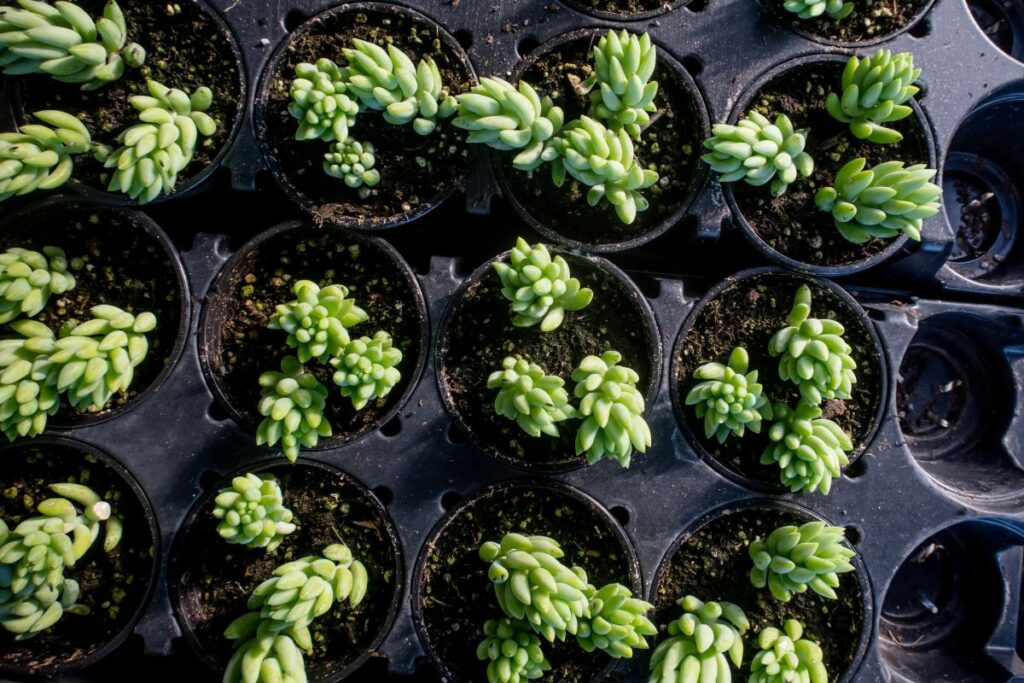
Contents
- 1 When To Propagate Burro’s Tail Succulent
- 2 Propagating Burro’s Tail Succulents with Stem Cuttings
- 3 Burro’s Tail Propagation By Leaf Cuttings
- 4 Burro’s Tail Propagation By Division
- 5 Caring For Newly Propagated Burro’s Tail Succulent
- 6 Frequently Asked Questions
- 6.1 How long does it take for burro’s tail to propagate?
- 6.2 Can you propagate burro’s tail in water?
- 6.3 How can I make my donkey tail grow faster?
- 6.4 How often should I water my burro’s tail?
- 6.5 Can burro’s tail survive winter?
- 6.6 What is the best soil for burro’s tail?
- 6.7 How do you take care of a burro’s tail indoors?
- 6.8 How long does it take to propagate burros tail leaves?
- 7 Conclusion
When To Propagate Burro’s Tail Succulent
If you’re excited to propagate burro’s tail succulents and want to achieve success, it’s essential to know the perfect time to do it. The best time for propagation is during the plant’s active growth cycle, which usually happens in late spring and early summer. It’s essential to choose healthy stem cuttings from a mother plant during this period. Now that you know the right time to propagate, let’s dive into our exciting little project!
Propagating Burro’s Tail Succulents with Stem Cuttings
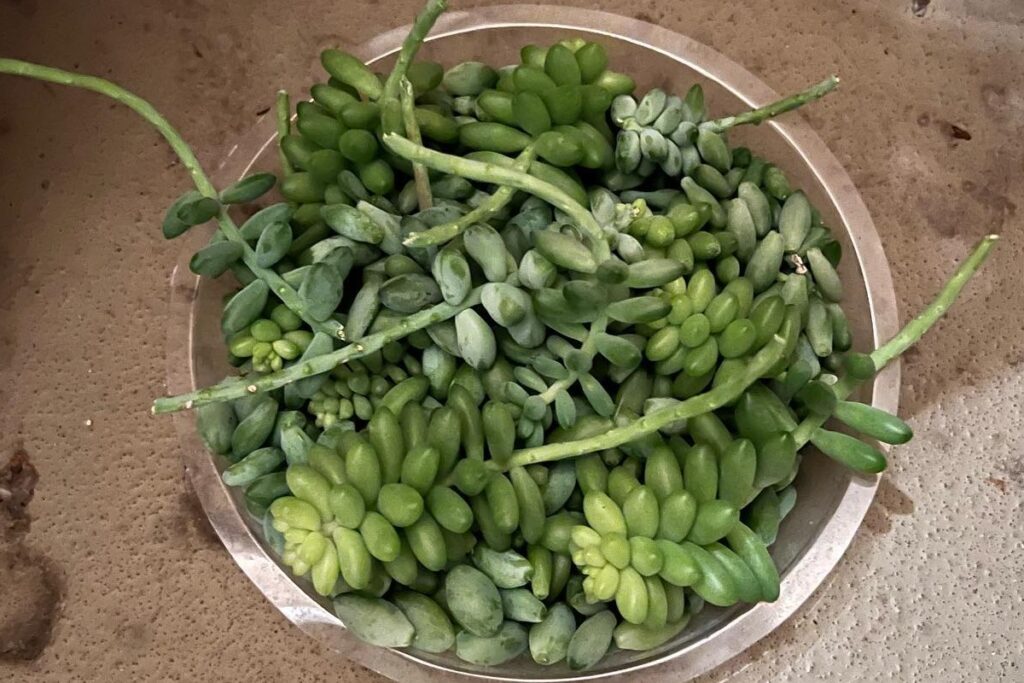
Let’s start by learning how to propagate these lovely succulents in soil:
- Gather stem cuttings from a healthy mother plant during the plant’s active growth cycle, usually in late spring or early summer.
- Each cutting should have at least one leaf attached near the tip of the stem to provide sustenance until roots develop.
- Plant the cuttings in clean containers filled with well-draining soil that contains some sand or perlite for good drainage.
- Choose a bright area with indirect sunlight, such as a windowsill, to place the pots.
- Water the cuttings about once every two weeks, ensuring you don’t overwater them.
- For better success, mist the soil daily while the cuttings are rooting and rotate your containers to provide equal light exposure.
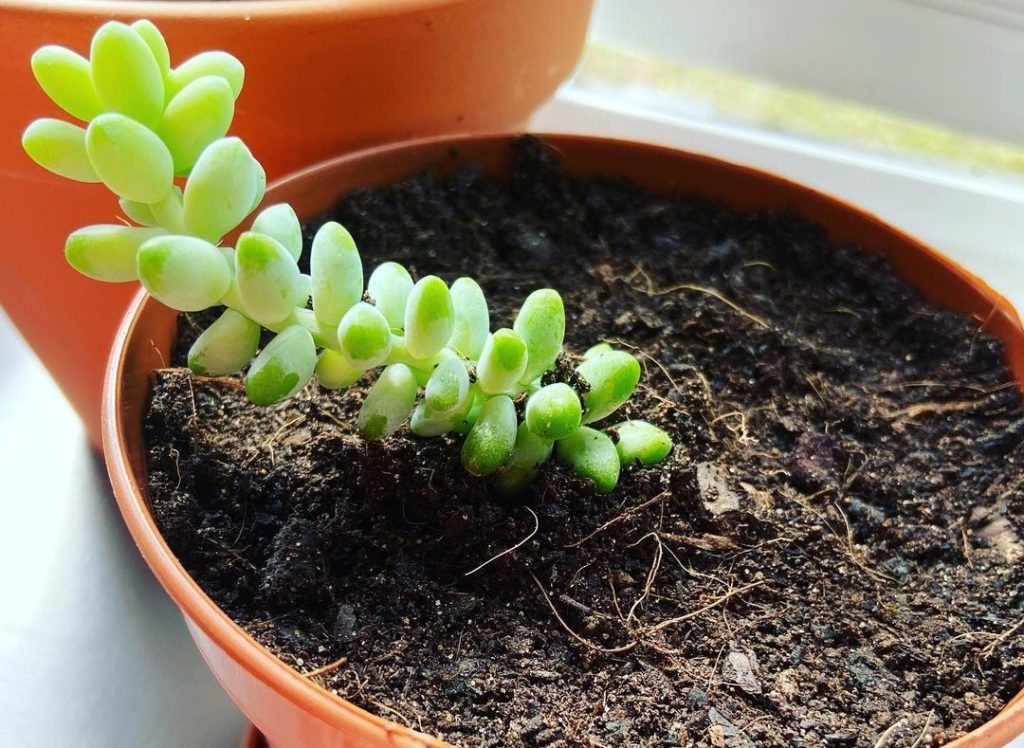
Note: Mist the cuttings to keep the soil slightly moist but not soaked, and make sure the containers have proper drainage.
Another way to propagate burro’s tail succulents is by using water. It’s an easy and rewarding method. Follow these simple steps:
- Take individual leaf cuttings from a healthy plant.
- Fill a container with enough water to submerge all the stems.
- Place your cuttings in the water and watch them develop roots within a few weeks!
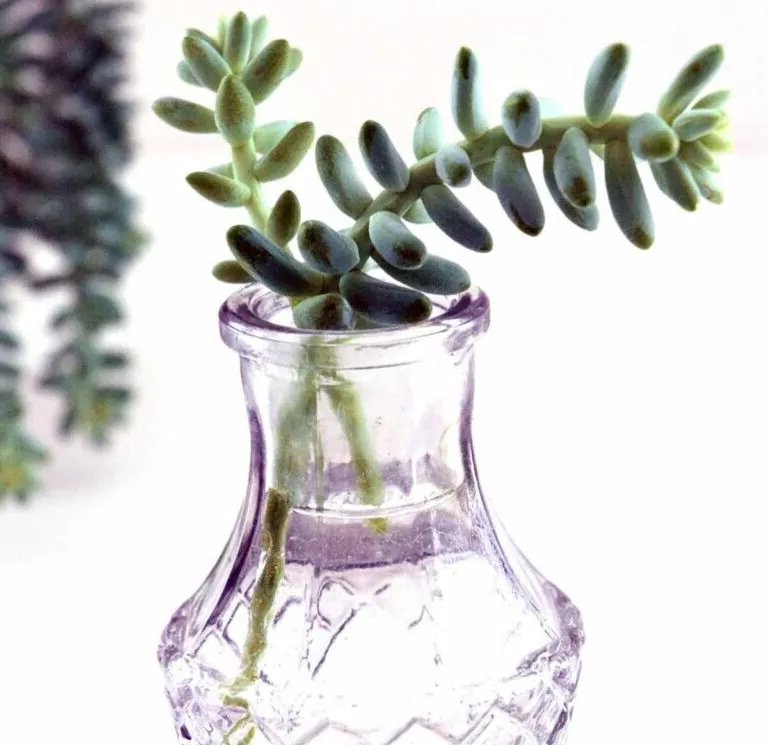
Caring for these new plants is straightforward. Just remember to keep the environment moist but not soggy by changing the water every other week or when it becomes murky. You may need to remove any yellow or brown leaves that can affect the health of the propagated plants. With these easy tips, you’ll soon have a collection of beautiful succulents thriving in your home!
Related Post:
Burro’s Tail Leaves Falling Off: 3 Causes and Solution
Burro’s Tail Propagation By Leaf Cuttings
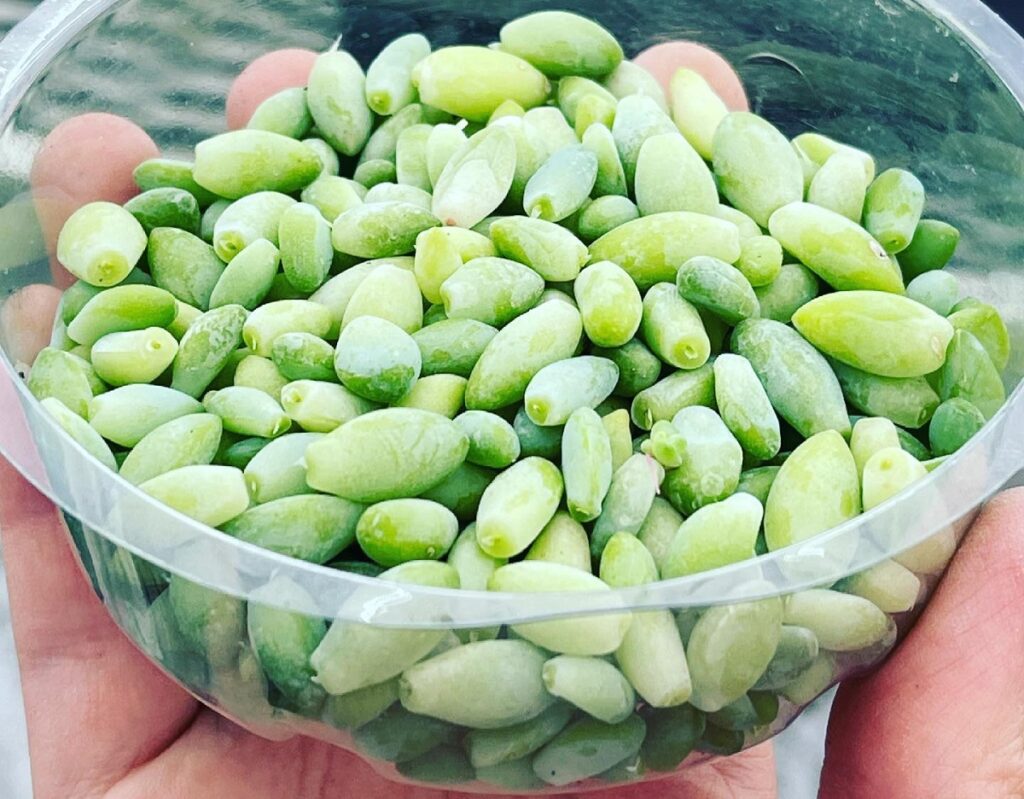
If you want to propagate burro’s tail plants with minimal effort, propagating them from leaf cuttings is the way to go. The ideal time for leaf propagation is in the spring when the leaves are juicy, green, and healthy. Follow these step-by-step instructions:
- Select healthy individual leaves from your existing Burro’s tail plant, ensuring they are undamaged and free from discoloration.
- Place the selected leaves on well-draining soil mix or moistened sphagnum moss.
- Keep the cuttings away from direct sunlight until they develop roots. Water them regularly but moderately, avoiding over-saturation as they grow.
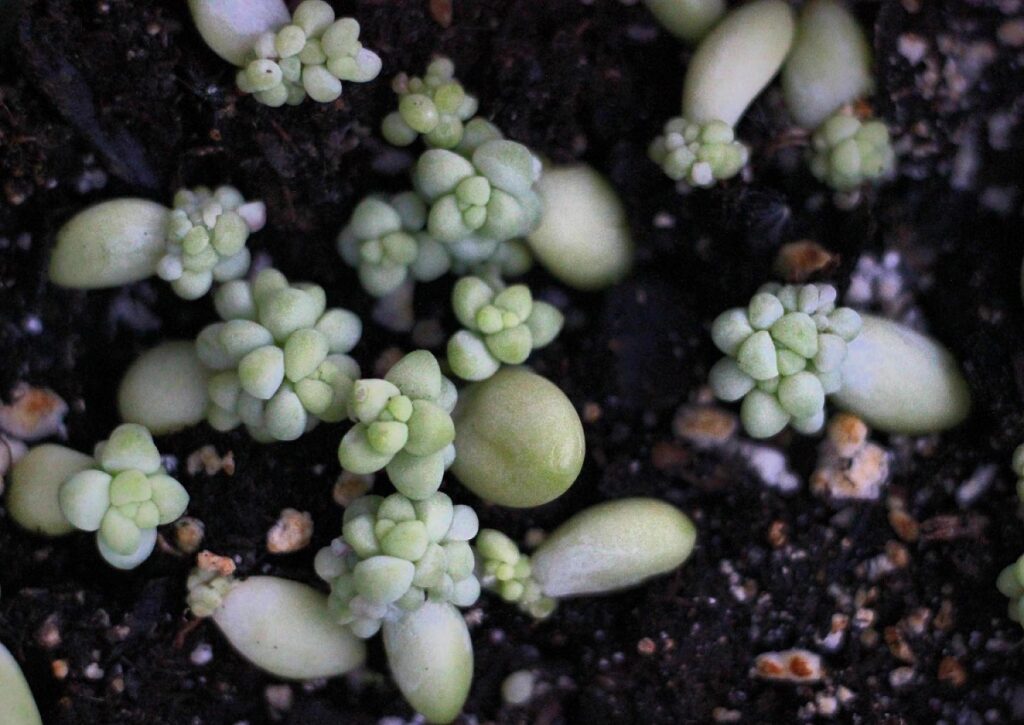
Burro’s Tail Propagation By Division
In addition to leaf propagation, you can also propagate burro’s tail by division. This method allows you to create multiple healthy plants from a single succulent. Follow these steps:
- Ensure your plant is well-established and has multiple stems growing from its base.
- Carefully remove the entire plant from its pot, using your hands or a spoon.
- Gently separate each stem into individual pieces, ensuring that each piece has some roots.
- Place each divided section in a pot filled with well-draining soil suitable for succulents and cacti. Ensure the pots have drainage holes and use a high-quality soil mix for optimal growth.
- Position the newly potted sections in a place with plenty of indirect light throughout the day. Avoid excessive sun exposure, as burro’s tail plants are delicate and can easily get sunburned.
- Water lightly as needed and only when the topsoil feels dry to the touch. Overwatering can cause root rot, so be cautious!
Once your propagated Burro’s tail plants are established, continue providing them with bright indirect light and allow the soil to dry out between watering sessions.
Caring For Newly Propagated Burro’s Tail Succulent
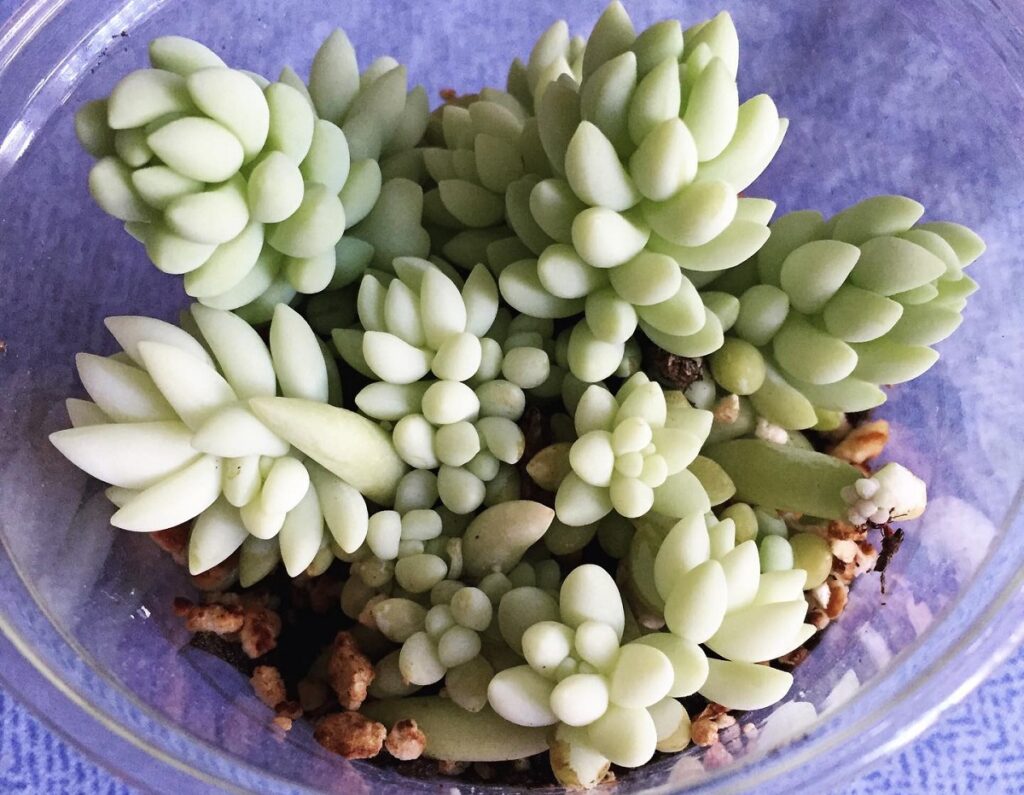
Congratulations on successfully propagating your Burro’s tail succulents! Now it’s time to care for the new plants so they can grow into healthy and happy adults. Here are some tips:
- Potting Soils: Use well-draining potting soils, avoiding soil from outside as it may contain harmful bacteria or parasites.
- Bright Light: Place the newly propagated Burro’s Tail indoors in bright light for optimal growth. Avoid direct sunlight, as it can damage their delicate leaves.
- Watering Schedule: Succulents require minimal water, so make sure not to overwater your new plants. Water them once every two weeks, allowing the soil to dry out in between. Shrivel or wilted leaves indicate insufficient water.
By following these guidelines, along with regular pruning if necessary, you’ll witness your Burro’s tails grow and thrive over time. With patience and dedication, you’ll soon have a delightful collection of succulents to adorn your home or garden!
Frequently Asked Questions
How long does it take for burro’s tail to propagate?
It generally takes about two to three months for a burro’s tail to propagate. The process starts with stem cuttings taken from the mother plant. These cuttings should be placed in well-drained, sandy potting mix and kept in bright, indirect sunlight. Consistently moist soil, regular fertilization every other month, and optimal care will help the burro’s tail fully propagate within the time frame.

Can you propagate burro’s tail in water?
Yes, you can propagate burro’s tail in water. Simply cut a 4-inch stem piece, remove the bottom leaves, and place the cut end in a glass of water. Ensure the leaves don’t touch the water and keep the glass in a well-lit area. Change the water every few days, maintain the water level above the cut end of the stem, and roots should start forming within a few weeks. Once the roots are about an inch long, transfer the stem to a pot with well-draining succulent soil and provide proper care.
How can I make my donkey tail grow faster?
To encourage faster growth, plant the donkey tail in a well-draining succulent soil mix. Add a slow-release fertilizer following the manufacturer’s instructions. Provide the plant with plenty of bright, indirect sunlight and water it regularly without letting the soil dry out completely.
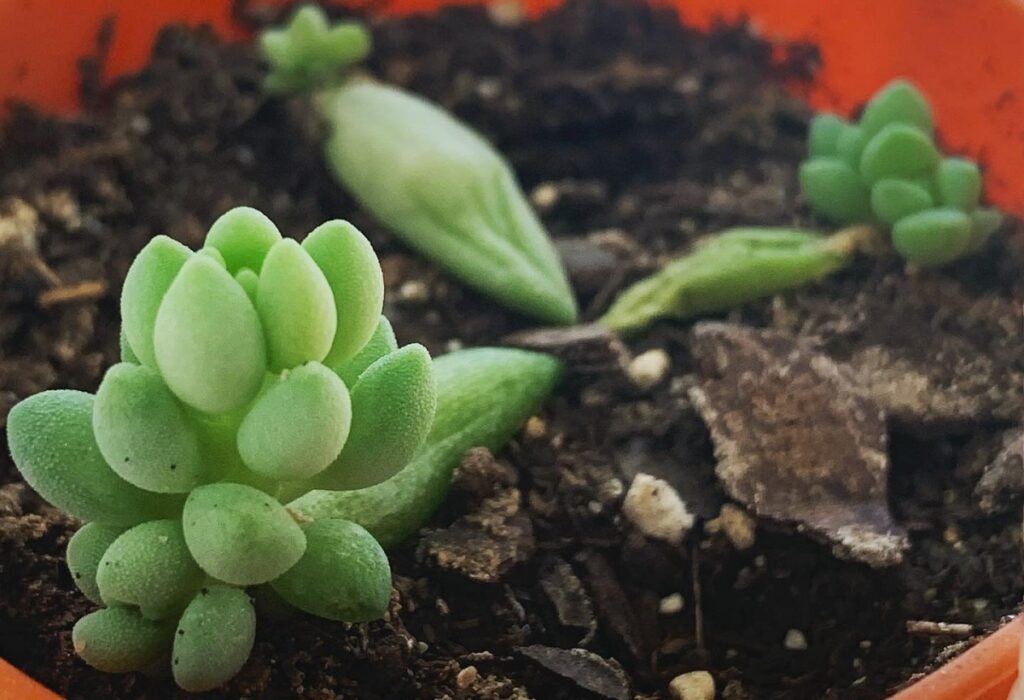
How often should I water my burro’s tail?
Water your burro’s tail every 7-10 days, allowing the soil to dry out between waterings. Adjust the frequency based on environmental factors like humidity and temperature. If the leaves appear droopy or wrinkled, it’s a sign of needing more water. Thoroughly soak the soil when watering, but be careful not to overwater and cause root rot.
Can burro’s tail survive winter?
Burro’s tail plants are not suitable for cold winter climates. They cannot tolerate temperatures below 50°F (10°C) or frost. To protect them, keep them indoors in a well-lit area, away from direct sunlight. Water the plant moderately and avoid overwatering. If any winter damage occurs, trim the damaged areas and repot with fresh soil to aid recovery.
What is the best soil for burro’s tail?
The best soil for burro’s tail is a well-draining succulent soil mix that includes sand, perlite, peat moss, and a small amount of compost or worm castings for nutrients.
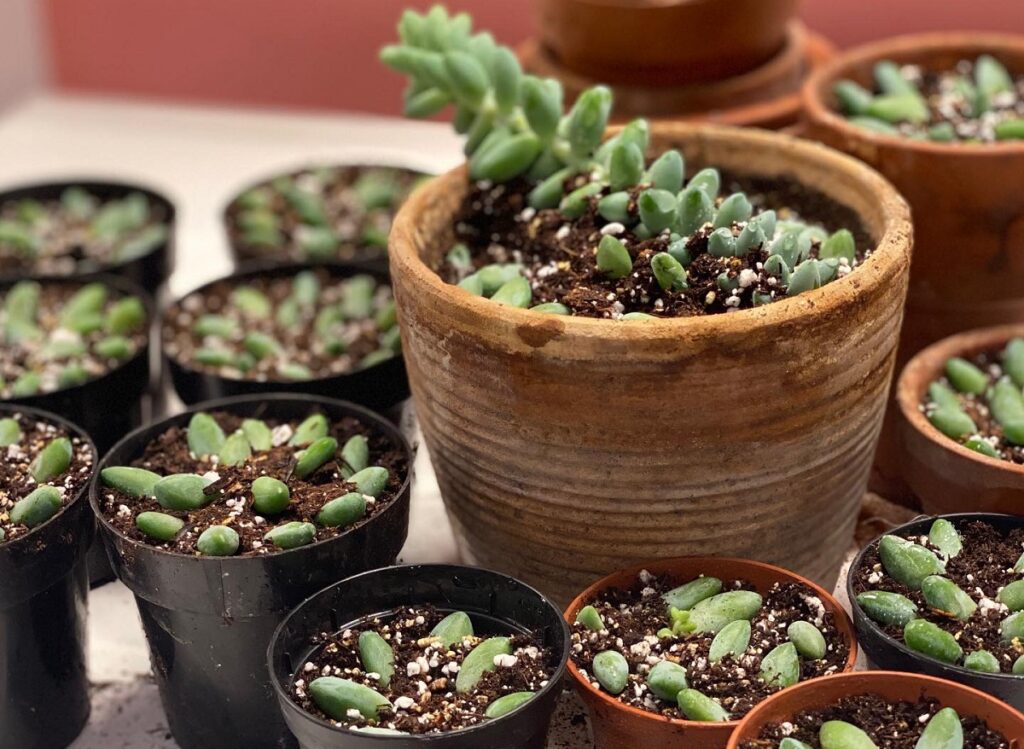
How do you take care of a burro’s tail indoors?
Use a pot with good drainage and well-draining soil. Place the succulent in a spot with bright, indirect light. Water the plant slightly and allow the soil to dry out completely before watering again. Maintain a suitable temperature (65-75°F) and be cautious not to overwater. Pruning is not necessary, but if needed, remove dead or damaged leaves.
How long does it take to propagate burros tail leaves?
Burro’s tail leaves typically take around 2-3 months to propagate. Factors like humidity and care can influence the growth rate. Using a rooting hormone and keeping the soil moist but not soggy can accelerate root growth. Providing adequate light and ventilation to the propagated leaves will help ensure their health and successful propagation.
Conclusion
In conclusion, propagating and caring for burro’s tail succulents can bring beauty and joy to your home. Remember to consider important factors such as light, water, soil, and temperature to ensure the optimal growth of your plants. With a little patience and attention, you’ll have a thriving collection of burro’s tails that will lend a touch of nature’s elegance to your indoor space.
